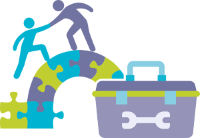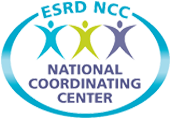 Background
Background
The Kidney Connection Patient Peer Mentoring Program offers a structured environment for people with kidney disease to develop one-on-one relationships while providing experiential support from peer mentors to peer mentees. In addition, it advocates for patient education through the Kidney Learning Hub, the program’s learning management system, and encourages patient peers to engage one another to remain active by sharing the lived experiences of their ESRD journey. The strategies and tactics referenced in this toolkit offer a starting point for ESRD Networks to develop and implement this program in their service areas.
 To help frame the Kidney Connection Patient Peer Mentoring Program implementation, explore the following questions:
To help frame the Kidney Connection Patient Peer Mentoring Program implementation, explore the following questions:
- Are there patients who might benefit from peer mentoring?
- How might patient peers improve engagement and adherence to treatment plans?
- How might patient peers improve referrals to home dialysis and transplant?
- How might the knowledge and skills of dialysis Facility Patient Representatives (FPRs) and Patient Advisory Council (PAC) members support peer mentoring efforts in their facilities?
To create a successful program, think about incorporating these program goals:
- Support new patients in understanding what treatment options are available to them.
- Share the skills and knowledge of experienced patients with new patients.
- Foster open communication and dialogue.
- Encourage patients to self-refer or accept referrals to a home dialysis program and/or the transplant waitlist.
- Empower patients to become informed decision-makers in their care plans.
- Provide support in locating and accessing resources, including community support.
To assist in determining how to measure the success of the program, consider the following tactics:
- Establish several Network-specific goals and objectives.
- Substantiate and validate program measures with a dialysis facility sample.
Tips for Operationalizing the ESRD Network Peer Mentoring Program
ESRD Networks should encourage dialysis facilities to discuss the Kidney Connection Patient Peer Mentoring Program with patients at chairside, during care plan meetings, through Lobby Days (when they return), and engage the FPRs to help promote the program. The dialysis facility and ESRD Network staff should be receptive to patient interest, even when a patient may not meet the outlined criteria to be a mentor or mentee. The materials below serve to help the Networks promote the program with dialysis facilities and can be adapted to meet individual Network needs.
![]() When recruiting dialysis facilities to participate in the Kidney Connection Patient Peer Mentoring Program, ESRD Networks should use a data-driven and relationship-centered approach to garner interest. Consider conducting a scan of dialysis facilities in the Network service area to learn of existing programs and opportunities or the need for a program. Review individual dialysis facility patient demographics, including the number of new patient admissions; prevalence vs. incidence; long-term, empowered and engaged patients; availability of ongoing support groups within the dialysis facility or community; and penetration rates for home dialysis and transplant. FPRs and PAC members may also be a supportive resource in identifying potential dialysis facilities to participate in the program.
When recruiting dialysis facilities to participate in the Kidney Connection Patient Peer Mentoring Program, ESRD Networks should use a data-driven and relationship-centered approach to garner interest. Consider conducting a scan of dialysis facilities in the Network service area to learn of existing programs and opportunities or the need for a program. Review individual dialysis facility patient demographics, including the number of new patient admissions; prevalence vs. incidence; long-term, empowered and engaged patients; availability of ongoing support groups within the dialysis facility or community; and penetration rates for home dialysis and transplant. FPRs and PAC members may also be a supportive resource in identifying potential dialysis facilities to participate in the program.
Peer Mentors:
- Are adults over the age of 18.
- Have been receiving in-center or home dialysis or have been transplanted for at least 6 months.
- Are actively engaged in the care plan.
- Consistently demonstrate leadership qualities at dialysis facility Quality Assessment and Performance Improvement meetings, Lobby Days, and other dialysis facility activities.
- Wish to be a peer mentor.
Mentees:
- Are over 18 years of age.
- Are newly diagnosed patients who have been on in-center dialysis for at least 6 months.
- Are looking for peer support to help them transition to their new reality.
- Are known as a peer mentee.
ESRD Networks should refer to their SOW for a complete list of attributes and requirements for peer mentors and mentees.
Last, identify a program coordinator or Peer Mentoring Champion at the Network and suggest that dialysis facilities also appoint a staff member as the Peer Mentoring Champion at the facility. Creating a position to communicate the program purpose can help ensure program consistency, streamline workflow, and provide a central place for program knowledge.
The referral form below can be used to nominate a mentor or mentee from a dialysis facility to his or her ESRD Network. Should a peer referral form be received directly by the Network, it is recommended that the Network inform the dialysis facility of the referral.
For healthcare workers, download Talking Points for Turning Down a Mentor or Mentee Applicant to assist with questions your patients might have.
Once the dialysis facility or Network has identified a peer mentor and/or mentee, the dialysis facility or Network should provide the application to the potential patient peer to complete. ESRD Networks that receive a peer mentor or mentee application directly should contact the peer's dialysis facility to make sure the staff is aware of the application. Upon receipt of the completed application, the ESRD NCC will upload the application to the Network-specific folder in FileCloud and notify the Network EDs, PSDs, and QIDs when the upload is complete. The ESRD Network Peer Mentoring Champion should transfer the application information to the encrypted Kidney Connection Patient Peer Mentoring Program tracking spreadsheet, which is also available in FileCloud.
- Peer Mentor and Mentee Application Form (Printable PDF)
- Peer Tracking Spreadsheet (Excel)—Password Protected Document Posted to the Network Filecloud Folder
![]() The Kidney Learning Hub is an online learning management system where basic and topic courses are available for peer mentors. As part of the qualification to become a peer mentor, peers are expected to complete the three basic courses and at least one topic course of their choice. Peer mentees are asked to review the course, titled What the Peer Mentee Should Know. Following the completion of the courses, there will be an orientation call for mentors and mentees. Peers should have completed the course assignments prior to attending orientation.
The Kidney Learning Hub is an online learning management system where basic and topic courses are available for peer mentors. As part of the qualification to become a peer mentor, peers are expected to complete the three basic courses and at least one topic course of their choice. Peer mentees are asked to review the course, titled What the Peer Mentee Should Know. Following the completion of the courses, there will be an orientation call for mentors and mentees. Peers should have completed the course assignments prior to attending orientation.
Peer orientation is a great way for peers to get to know each other. Orientation offers mentors and mentees the opportunity to meet each other in a virtual setting by phone and/or Webex™ or Zoom™. While knowledge transfer is essential to a successful orientation, there should also be ample time for peers to ask questions and share information. The communication exchange from peers during orientation can help to shed light on personal attributes and preferences that may contribute to successful peer pairings. As previously noted, peers are expected to complete orientation prior to being paired.
Orientation also serves to provide greater details about program expectations, information about how to ask for assistance, and whom to communicate with about your peer mentoring experience. Upon finishing the courses and orientation, peer mentors will be given a Certificate of Completion. The certificate acknowledges that the peer has completed the necessary activities to become a peer mentor; however, it does not certify the peer as a peer mentor. The following resources are available to support peer mentoring training and orientation.
The orientation presentation provides a template for Network orientation sessions. Networks may wish to adapt the content to meet their unique needs.
- Peer Mentoring Orientation Presentation (PowerPoint)
- Kidney Learning Hub (Website)
- Kidney Learning Hub User’s Guide (PDF)
- Kidney Learning Hub Frequently Asked Questions (PDF)
- Peer Mentoring Course Resources (PDF)
- Peer Mentor Frequently Asked Questions (PDF)
- The ESRD Network Peer Mentoring Program Patient Journal Intro (PDF)
- The ESRD Network Peer Mentoring Program Patient Journal (PDF)
Downloadable and Printable Black and White Course Materials (PDF)
- Course 1 Welcome
- Spanish Course 1 Welcome
- Course 2 Mentor Support
- Spanish Course 2 Mentor Support
- Course 3 ESRD Overview
- Spanish Course 3 ESRD Overview
- Course 4 Discussing Home Dialysis
- Spanish Course 4 Discussing Home Dialysis
- Course 5 Discussing Transplant
- Spanish Course 5 Discussing Transplant
- Course 6 New to Dialysis
- Spanish Course 6 New to Dialysis
- Module: Staying Active and Involved If You Have Kidney Disease
- Spanish Module: Staying Active and Involved If You Have Kidney Disease
- Module: Putting Your Well-Being First
- Spanish Module: Putting Your Well-Bring First
Certificates of Completion (Word):
The first step of pairing is to review each peers’ application for complementary hobbies, interests, gender, age, language preferences, and treatment options. For in-person pairings, consider the timing of mentor and mentee treatments and transportation and try to coordinate so that peers can meet before or after their treatment. Using the peer application and in collaboration with the dialysis facility, patient peers should have similar communication styles, for example pairing a more introverted mentee with a reserved or soft-spoken mentor. Be sure to consider and honor native languages and gender preferences, whenever possible. Situations can arise where the dialysis facility or Network Peer Mentoring Champion may need to intervene to support the peers. Always be mindful that sometimes pairings just don’t work out, and no one is to blame should this happen. Encourage the mentor and mentee to try meeting again or consider being paired with another patient peer.
Below are some reasons why peer pairings may need to be reassigned or even dissolved:
- A mentor or mentee seeks resources beyond the scope of the program (e.g., requests financial support, medications, medical advice, etc.).
- Peers break confidentiality.
- Peers cannot continue the program for any reason (going back to work or school, caring for a family member, transportation issues, phone issues, etc.).
- A mentor or mentee becomes ill, hospitalized, or dies.
This is a sample confidentiality waiver, which can be signed by both the mentor and mentee.
The resources below can be found on the Kidney Learning Hub and are deigned to support peers in their mentoring relationship.
![]() The Kidney Connection Patient Peer Mentoring Program relies on collaboration between ESRD Networks, participating dialysis facilities, and patient peers to ensure program success. ESRD Network Peer Mentoring Champions work closely with dialysis facility staff or dialysis facility Peer Mentoring Champions to promote regular check-ins with mentors and mentees. This helps ensure that mentor and mentee concerns are identified and dealt with effectively and efficiently, so everyone benefits from the program.
The Kidney Connection Patient Peer Mentoring Program relies on collaboration between ESRD Networks, participating dialysis facilities, and patient peers to ensure program success. ESRD Network Peer Mentoring Champions work closely with dialysis facility staff or dialysis facility Peer Mentoring Champions to promote regular check-ins with mentors and mentees. This helps ensure that mentor and mentee concerns are identified and dealt with effectively and efficiently, so everyone benefits from the program.
Peer Mentoring Champions should regularly review submitted peer mentor logs to identify any issues or successes on which mentors report. Peer Mentoring Champions should also ensure that mentors have the information they need to feel confident in talking with mentees. It is possible that mentees may sign up to participate but not return calls or seem to avoid meeting with their assigned mentor. Peer Mentoring Champions should be prepared to suggest solutions if mentors have difficulty meeting or contacting mentees.
From time to time, Peer Mentoring Champions may need to get involved in the peer relationship. As a Peer Mentoring Champion, in their professional role, Network and dialysis facility staff are capable of providing support to peers when needed. For the program to be a success, it is essential for Peer Mentoring Champions to remain connected to and supportive of the mentor and mentee relationship. Below are additional resources for Peer Mentoring Champions to share and or use throughout the life of the program.
- Dialysis Facility Role (PDF)
- ESRD Network Role (PDF)
- Kidney Learning Hub Course Evaluations (PDF):
- The ESRD Network Peer Mentoring Program Satisfaction Assessment (PDF)
- Peer Mentor Log (Fillable PDF)
Mentoring in a Virtual World
The ESRD NCC recognizes that everyone’s focus is on managing initiatives to mitigate the spread of COVID-19 and ensuring the safety of staff and patients during the pandemic. Initially, it is recommended that peers meet virtually using applications such as Zoom™, Google Hangouts™, or Google Voice™. It is also recommended that peers do not share personal cell phone information with each other. The orientation meeting should address how to set up a free Zoom™, Google Hangout™, or Google Voice™ account.
Returning to In-Person Meetings
Ideally, peers will be able to meet at their dialysis facility. If a separate meeting area is identified within the dialysis facility, ensure that peers feel comfortable and the area is as private as possible. It is also acceptable for peers to meet outside of the facility, if this is more convenient. Some ideas on outside locations include, coffee shops, local parks, church halls, or library social rooms, etc. Peers should always mutually agree on the meeting location and meet in a quiet, yet publicly accessible area. Peers should never agree to meet at each other’s homes.
![]() Perhaps one of the greatest rewards of the Kidney Connection Patient Peer Mentoring Program is the potential to a make a positive difference in someone’s life. Through collaboration and partnership between dialysis facilities and ESRD Networks, the ESRD Network Peer Mentoring Program provides the opportunity for healthcare professionals and patient peers to make a difference in the quality of life of people with kidney disease. While this toolkit cannot possibly contain all the answers to creating a successful peer mentoring program, it does provide the framework for Networks and facilities to consistently advance a national approach to peer mentoring within their service areas.
Perhaps one of the greatest rewards of the Kidney Connection Patient Peer Mentoring Program is the potential to a make a positive difference in someone’s life. Through collaboration and partnership between dialysis facilities and ESRD Networks, the ESRD Network Peer Mentoring Program provides the opportunity for healthcare professionals and patient peers to make a difference in the quality of life of people with kidney disease. While this toolkit cannot possibly contain all the answers to creating a successful peer mentoring program, it does provide the framework for Networks and facilities to consistently advance a national approach to peer mentoring within their service areas.
